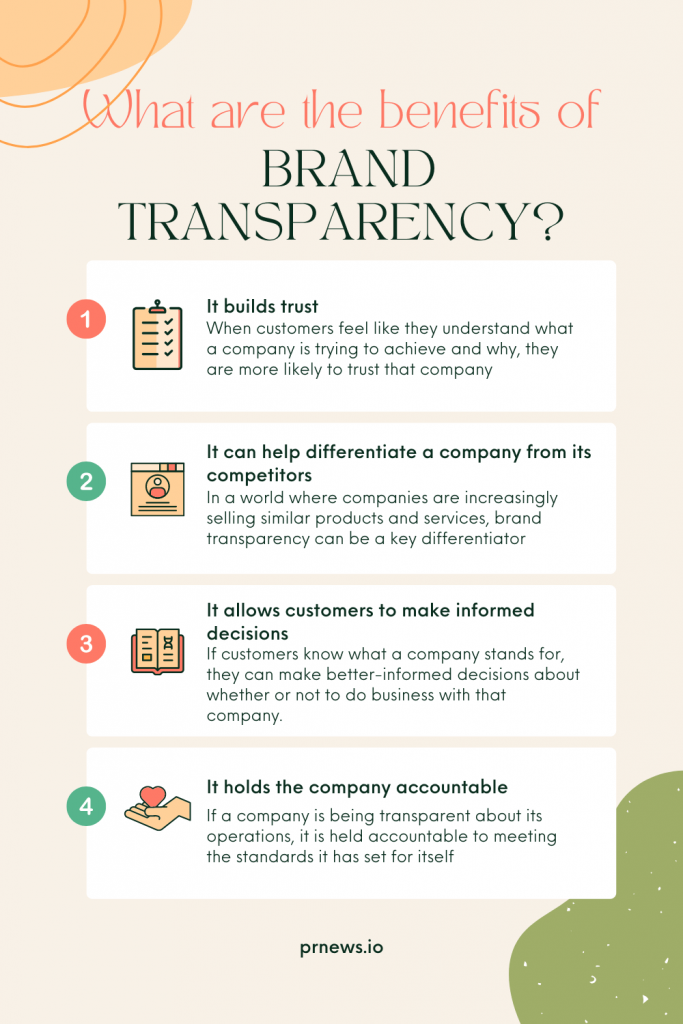
Brand transparency is the process of being completely honest and up-front with your customers about what you do and how you do it. It is observed that brands who are transparent towards their audience have been rewarded for various things such as gaining consumers’ trust, increasing sales, and boosting brand reputation.
Authenticity means the way brands connect with consumers regardless of transactions. When brands stand unique from competitors with a clear and concise message that explains their values, they get the opportunity to connect honestly with their audience.
Brand transparency means a strategy of revealing information about the brand to increase customer trust.
Corporations and investors mostly avoid surprises and invest their money into startups open to media contacts. And customers are more loyal to the companies they consider trustworthy. It matters to them who and how create the products they buy. The fewer secrets brands have—the more people trust them.
Build Positive Online Reputation & Remove Negative from SERP
What is Transparency?
Transparency of the brand refers to how open, genuine, and accessible the brand is to its internal and external stakeholders. In a transparent brand, goals, values, prices, operations, financial statements, and even sensitive data, such as the business’s environmental impact, are shared.
A brand’s transparency can mean different things to different brands, and it also varies by industry. As long as the main principle remains consistent: honesty and transparency, nothing can go wrong.
Transparency is great but , one must be careful what you are being transparent about
Let’s analyze what a transparent business is: it is a style of doing business when the company speaks openly about everything that happens inside – numbers, successes, and failures, employees and their achievements, etc.
If decisions and any important information are not hidden from employees, their loyalty and trust in the company and top managers increase. This means that productivity increases. Employees feel they are an important part of the company, so they are more likely to show initiative and work with greater enthusiasm.
Transparency also attracts talented people. Potential employees are more willing to work for companies that inspire confidence and speak of stability and respect in the team.
It is definable one of the best business practices. There are others.
Remember we buy from people we Know, Like, and Trust.
How does one accomplish that?
You prove to your prospects that you are sincere, honest, and transparent.
You do not bait and switch, you do not change any significant policy or procedure without letting them know.
You build up your authority with them by showing them you are well-versed with your product/service.
And you regularly engage them with Relevant, Valuable, and Educational information about their pain and problems, never about yours.
Transparency is great when you are discussing pricing with your clients to prepare them mentally and financially.
On the other side: how you do it, when, who, cost, and the supply chain of the product. You can keep this to yourself as this will be the business’s secret.
In short, be transparent towards clients over the pricing, quality, and products suitable to their consumption but how is your business secret.
Simply explained, brand transparency is a glimpse into the inner workings of your brand. Transparency refers to demonstrating to customers what your business’s working culture is like, what your brand stands for, and, of course, your honest views of your brand.
Hector Ruiz
A transparent brand consists of three elements:
- A company’s policies and performance are clearly communicated to experts (or how it is progressing).
- Providing proof to customers (or answering the question, “What do I buy?”) is the brand’s role.
- What is the brand’s purpose? Brand purpose is to communicate values and beliefs to customers (or answer the question, “Does this brand align with my values?”).
A brand’s transparency can mean different things to different brands, and it also varies by industry. As long as the main principle remains consistent: honesty and transparency, nothing can go wrong.
Why Do Brands Need Transparency?
- Brand awareness
- Trust
- Loyalty
- Reputation
Brand awareness. The more brand falls into the sight of customers, the more products it sells.
Trust. The easier people find info about the brand – the more they trust it. It means it doesn’t keep anything from its buyers and is ready to hold responsibility for defective products and other issues.
“I was choosing a toothbrush. I spotted a new brand on a shelf. But Google didn’t find any mentions of it. So, I just have bought the same brand I used to buy.”
Statistics show that 86% of mothers from 18 to 34 are ready to pay more for products of more open brands.
Loyalty. Stores are jam-packed with various brand products. The choice becomes tougher and tougher. And when a buyer finds a product of a brand they trust, they stop looking for other brands. It means that customers are satisfied with their choice and have no need for other products.
Brand awareness also helps to cope with these issues. Recent cases with Samsung’s exploding Galaxy Note 7S showed that no matter how hard the issue is, people still trust Samsung and buy their smartphones.
Otherwise, such issues could have buried the less famous brand. Users avoid having a deal with brands they’re not sure of to solve the issues fast.
Brand transparency also improves the company’s reputation. A brand that shares its values becomes relatable to its target market. But brand transparency should also concern internal affairs. Employees must be aware of company decisions and direction to embody the company’s culture and goals.

How Brands Ensure Relationships with Millennials and Generation Z
Millennials and Generation Z are the main consumers today. Millennials are those born in the late 1980s while generation Z are youngsters of age 20 and teenagers.
The average number of Generation Z consumers in the U. S. and Britain reaches 26% today. JWT Intelligence studies show that 73% of Gen Z pay huge attention to the brand of the products they buy. Brands are an important part of their life.
Studies show that Millennials and Gen Z consider building trust-based and transparent relationships with brands as very important. Products they consume every day define their lifestyle and outlook.
The attitude of Millennials and GenZ to brands is different from that of previous generations, claims Norty Cohen, Moosylvania Agency founder:
“Millennials are not consumers and especially not targets in a military-style marketing blitz – they’re friends. We trust friends who listen to us, are open and honest, remember our name, are consistent, and stay true to themselves.”
Aside from transparency and honesty, youngsters see brands take into account the atmosphere that the brand creates.
The study of the behavior of Yahoo, DigitasLBi, Razorfish, and Tumblr users contains the following recommendations:
- Set the mood. Create emotions and share impressions.
- Help your audience to escape humdrum by inspiring them to live life to the fullest.
- Be creative: use absurd collages, bright installations; make use of memes and modern concepts.
- Don’t discard pop-culture: make references to celebrities and arouse notes of nostalgia.
- Be useful: create “how-to” posts, lifehacks and other educating info.
- Re-discover old topics and help your audience to look at them from a different perspective.
Surround your audience with the brand atmosphere. It can be hard because you need to be sensitive to the audience’s needs. And to be brave as well. E.g. like Diesel:
From the personal brand perspective this ethical approach can be seen as being more “natural” or “authentic” on social media which is something that the GenZ generation tends to really appreciate vs their counterpart generations; saying the truth either is positive or negative is the epitome of transparency on today’s social media spectrum. Talking about companies and businesses, being transparent can be explaining or being more honest about your limitations, challenges or SOP’s in a way that customers and team members can feel secure about belonging and acquiring services.
A strategy known as “brand transparency” is a method that gives your product more authority by influencing the customer’s perception
Important Notes About Brand Transparency
- Display info about your products and services quality. Provide constant improvements to them.
- Let anyone share any info about your company – no matter whether those are good or bad reviews.
- Don’t hide info. Customers will get it anyway – from other sources, or spread rumors based on their own speculations.
- Customers wish to know more about the brand: its values, team and ideas it spreads to the world. People wish to know how products are created.
- Start monitoring mentions about your brand: media publications, social signals.
- Create a list of your brand’s weak points and make explanations for any customer complaint. Company members should know how to fight negativity on public media. Now solve the issues and work on product drawbacks.
- Check out how the processes work, be honest with your clients and do your best to improve your services. If brand lies to the customers – there’s no place for it in the big market.
Brand Transparency Example: McDonald’s Fights Negativity
Brand transparency is the willingness of business owners to share their practices, mission, and processes with the public.
McDonald’s is a company that has fought negative comments for a long time. There are tons of accusations of how its food harms people’s health. The term “fast food” itself is closely associated with junk food and the McDonald’s brand.
When a Canadian representative office experienced the worsening treatment of the McDonald’s brand, they launched a special project called “Our Food. Your Questions.” Any user was able to leave a question concerning McDonald’s products on the open page.
The brand already answered over 42,000 questions. About 3.8 million people visited the page. McDonald’s showed the videos from its farms where they grow the products for the chain of their restaurants.
Advertising posters that show the questions of McDonald’s customers
Customers are aware of the unhealthy properties of fast food. But they need to know more in order to make a wise decision.
McDonald’s speaks freely about its products, dispelling myths and fighting accusations. The more brand tells and shows about it, the less place for speculation is left.
Industry Experts about Brand Transparency
Lydia Boychuk, VP of Marketing at More Labs

One of the best definitions of brand transparency that’s crucial to remember is that it’s simply about building trust between you and your consumers. In today’s world, many are reluctant to take things at face value. This is where you come in, by changing this dynamic.
Don’t shy away from the fact that your brand isn’t perfect but communicate its vulnerabilities to your audience. They will be drawn to your connecting honesty and your brand. Maintain this level of openness with your customers, and your loyalty base will grow exponentially.
Deepanshu Bedi, Marketing Director at Holistapet

Brand transparency is a process of sharing with the public what the company is doing, how it’s doing it, and why it’s doing it. It differs from behind-the-scenes transparency in that it’s not about sharing the process of how the company operates but rather how it works. It’s about transparency and honesty about what is happening to the public.
Brand transparency is the idea that the true essence of a product or service is available to the customer without the need for advertising or marketing. It is accessible to the public through open language and clear, uncluttered visuals. In this way, what is not seen is as important as what is seen. Brand transparency is the idea that any brand’s authenticity should be easily visible to customers and not be hidden or obscured by marketing.
Vaibhav Kakkar, CEO and Founder of DigitalWebSolutions

In today’s hyper-connected world, brands need to be transparent with the public about what they are doing and why. Consumers have more power than ever before and can easily speak up and demand that brands answer their questions. A recent study found that 84 percent of consumers would switch brands or stop shopping with a brand if they felt their values didn’t line up.
There are a few reasons why brand transparency is so important in today’s business landscape:
1. Customers want it: In a world where customers have easy access to information, they expect companies to be transparent about their products and practices.
2. It builds trust: When customers feel they can trust you as a company, they’re more likely to do business with you and recommend you to others.
3. It sets you apart from the competition: customers are more likely to remember and choose companies that are open and honest about their products and practices over those that aren’t.
4. It can help you avoid problems: If there’s a problem with one of your products, being upfront about it can help you resolve the issue quickly and prevent it from damaging your reputation.
Mocca Bajao, Digital PR Specialist at Thrive Digital Marketing Agency

Brand transparency is how a brand shows its authentic self, especially during public interactions. It is an effective way to gain customers’ trust and loyalty. The concept of brand transparency mainly refers to a brand’s proactive efforts, to be honest.
Brand transparency involves communicating with customers and being open to mistakes. Brand transparency improves customer retention, strengthens the organization’s advocacy, and increases sales
Mika Tomada, a PR specialist from Pearl Lemon Group
Brand Transparency in its most basic form is having 100% clear glass on everything about your business in general. This would include your products, retails, principles, or services overall.
Being as transparent as possible ultimately promotes trust. Between different relationships either, staff to staff or staff to clients. It boosts morale and solidifies a dignity that would be seen by your customer base.
Being seen will also open you to every opinion in the market. And you can use this as an opportunity to improve. Take the ones that are reasonable and constructive, and improve around them.
Stephanie Venn-Watson, DVM, MPH

Building a transparent brand means being completely open and honest about all areas of your business. Beyond that, it’s important for companies to be candid about their mission and values by sharing the details on their websites. Not only does this build trust with onlookers, but it also promotes accountability for businesses to stay true to their standards and principles.
My company, for example, has made a commitment to sustainability, and we’re very transparent about that. We opt for reusable packaging and less frequent shipments, and we expect our customers to hold us to that standard.
Another good example of brand transparency can be found with one of my favorite companies — Mrs. Meyers Clean Day. They’ve made a commitment to quality, and their website contains an ingredients glossary that details all of the components in their household cleaning products.
Sophia Jones, Investment Analyst at PiggyBank

I think it’s easy to get caught up in the day-to-day grind of business and forget that people are watching and waiting for you to tell them what you stand for. You might think that no one cares what your company’s mission is, but they do—and it’s important that they know where you’re going and why so they can decide whether or not they want to follow along.
Brand transparency is all about building trust with your customers by being upfront about who you are as a company and what you stand for. Customers want to feel like they know where their money is going when they buy from you; if they don’t feel like it’s going somewhere good, then they won’t buy from you again.
There are many ways companies can build brand transparency into their marketing strategies:
- Publishing an annual report on social media or through email.
- Adding information about the company’s values on product packaging (e.g., “This product was produced using recycled materials”).
- Encouraging employees to share stories about working at your company.
Adam Crookes, Lead Generation Specialist at Unstuck Agency
For me, brand transparency is about building a relationship of trust with customers by sharing all the information they need to make an informed purchase decision. This includes everything from the company’s history and manufacturing process to the ingredients in its products and the way those products are sourced. Customers today are more interested than ever in knowing where their products come from and how they are made. They want to be sure that the brands they buy from are ethical and responsible and they are willing to pay more for products from companies that are transparent about their business practices.
Aima Irfan, Editor in Chief and Marketing Manager, InsideTechWorld

Brand transparency is the perception of consumers regarding a brand’s strategic efforts to make information available – be it positive or negative. The purpose is solely to improve their understanding and hold the brand accountable for its marketing efforts.
The reputation of being honest and open yields substantial benefits for advertisers. Therefore, the idea of brand transparency has received growing attention over the years.
Brand Copywriter and Strategist Chloe Barnes of The Write Chloe

Brand transparency is about building trust with internal and external stakeholders by being open and honest about the way you conduct business.
True transparency is more than a policy or a value—it’s entrenched in company culture. In practice, this can look like anything from disclaimers on enhanced (“Photoshopped”) photos, to publishing a press release about an error (like a data leak) before it appears in the news, to publishing the salary budget in a job ad.
Jon Paul, tutor at Lsattutor.NYC
Brand transparency is a way new theme or definition that came into existence in recent years. The term refers to the complete transparency that a customer has in a brand, where it means the trust of customers who believe in and purchase their goods and services. It’s more like giving respect and taking respect and this will help in giving them a better understanding of such factors as the growth of the company and customer reach in order to provide a well-satisfying service and goods that meet their expectation and needs.
Thomas Newman, Founder and CEO VIVA Financial Tuition

Brand transparency is the idea that consumers can see what goes on behind the scenes of a company or product. They want to know where your products are made, how they’re made, and what ethical decisions were made about those processes. It’s not just about the quality of the product—it’s about how it was made and why it was made that way.
The reason I think this is so important is that consumers want to know that they can trust a brand. When you look at a brand like Panera Bread, you can see exactly where every single piece of its product came from and how it was manufactured. That kind of transparency helps build brand loyalty because the customer knows exactly what they are getting from the company.
Daniel Foley, Founder of Daniel Foley SEO Consultancy

1. Brand Transparency:
These days, “brand transparency” is more than just a phrase; brands really do need to be completely open and honest with their customers about everything they do. In larger organizations with more employees, layers, and complexities, sustaining transparency isn’t always easy despite the seeming simplicity of the concept.
Providing a thorough price sheet upfront and not requiring clients to schedule an appointment with a sales agent to acquire a quote are both examples of how straightforward it can be for a business to be transparent with its customers. Transparency may also be more involved and difficult to implement without the aid of cutting-edge technology.
2. Employee engagement:
By providing open and honest performance evaluation systems that actually support individual and team growth, as well as including employees in decision-making processes, a brand may increase employee engagement. To achieve this goal, it is important to facilitate in-person interactions, as this is the medium through which non-verbal communication can have the greatest influence and through which human ties can be formed with the greatest ease. Employees can gain insight into how other parts of the business function through cross-departmental mentoring.
Adam Wood, Co-Founder of RevenueGeeks

In my opinion, the concept of brand transparency is more than just a marketing cliché; in today’s world, brands are expected to be transparent in all aspects of their operations.
Keeping one’s operations open and honest may appear to be a straightforward concept; nevertheless, this is not always the case, particularly in larger corporations that have a greater number of employees, levels of management, and intricacies involved in their organization.
Cody Candee, Founder and CEO of Bounce

Though there are many definitions of brand transparency in essence it is a business’s effort to put on display its authenticity. With the onslaught of digital advertising and social media, consumers have become weary of slick presentations that present a false narrative, with over 85% stating that transparency in a business is more important to them than it was previously.
By presenting the true stories of its founders, sharing both their successes and missteps, and presenting the real profiles of its team members, a business can showcase its authentic self. In the end, brand transparency is about choosing truth over the image, and building customer trust through an honest reflection of the business.
Geoff Cudd and I’m the Founder of Don’t Do It Yourself

Incorporating transparency into a brand’s strategy can be a powerful differentiator and driving force for business success. Brand transparency encompasses a company’s willingness and ability to openly communicate its values, ethics, business practices, and decision-making processes to both customers and stakeholders. This type of transparency builds trust with consumers and allows them to make informed purchasing decisions aligned with their personal values. Along with increasing consumer trust and loyalty, brand transparency can also improve a company’s reputation, attract top talent, and enhance partnerships with other organizations, primarily because it demonstrates a commitment to integrity and responsibility.
In today’s market, consumers seek brands that align with their values and prioritize ethical practices. The environment-conscious will most likely boycott companies without transparency surrounding their environmental impact. At the same time, those who prioritize diversity and inclusion may opt for brands that are open about their diversity initiatives.
Implementing brand transparency can also lead to improved company performance and decision-making. By openly communicating with stakeholders, a company can tap into valuable feedback and insights to drive innovation and improve overall operations from supply chain management to product development.
Helga Dosa, Head of Marketing for Brand Rated

Brand transparency is the practice of making a company’s brand identity, values, and purpose clear to consumers. This can be done through marketing campaigns, social media interactions, and other customer-facing activities. Brand transparency allows customers to understand what a company stands for and what it is trying to achieve. It also builds trust between a company and its customers, as customers feel they are being given honest information about the products or services they are interested in. Finally, brand transparency can help a company differentiate itself from its competitors, as customers are more likely to choose a company that is open and transparent about its operations.
What are the benefits of brand transparency?
- It builds trust: When customers feel like they understand what a company is trying to achieve and why, they are more likely to trust that company.
- It can help differentiate a company from its competitors: In a world where companies are increasingly selling similar products and services, brand transparency can be a key differentiator.
- It allows customers to make informed decisions: If customers know what a company stands for, they can make better-informed decisions about whether or not to do business with that company.
- It holds the company accountable: If a company is being transparent about its operations, it is held accountable to meeting the standards it has set for itself.
Meyr Aviv, Founder & CEO of iMoving

The term “brand transparency” is used to describe the practice of being open and honest about the sources of your product or service, the work that goes into making it, who makes it, as well as any environmental or social impact associated with it. This type of transparency can help to build trust with consumers, as they are able to see exactly where your products come from and how they are made. It also assures them that you are operating ethically and responsibly.
There are many benefits to being transparent as a brand.
In addition to building trust with consumers, it can also help to differentiate you from your competitors. If consumers know that they can trust you to be open and honest about your products and manufacturing process, they are more likely to choose your brand over one that is less forthcoming. Additionally, being transparent can help to build loyalty among your customer base, as they appreciate knowing that you are a responsible and trustworthy company. They would also be more likely to recommend your brand to others, which can bring in new customers and help to grow your business.
Brand transparency is not always easy, and it can be a challenge to strike the right balance between providing too much information and not enough. Just make sure that you are clear and concise in your communication, and be sure to provide consumers with the information they need to make an informed decision about your product or service. When done correctly, brand transparency can be a powerful tool for building trust, loyalty, and business growth.
Content Marketing Platform
- 100,000+ media publications;
- get backlinks to your product;
- scale work with content distribution.
Conclusion: Brand Transparency
- The more publicly available information a brand shares, the less negativity it attracts.
- Customers prefer brands that share stories about the brand and its inner processes.
- People are ready to change their tastes and pay more for products of more transparent brands.
- The audience doesn’t mind reading sponsored posts and native advertising if it is useful and entertaining.
Read more:
- How to Use SEO Brand Marketing to Boost Your Company
- Online Reputation Management: How to Shape Your Brand’s Perception?
- What Is Black PR and How to Fight with It
Save to Pinterest
You can save this page to your Pinterest board for later.

Brand Transparency FAQ
What is brand transparency?
Brand transparency is the extent to which a brand is open and honest about its operations, policies, and practices. This includes being transparent about its products and services, as well as its business practices and ethics.
Why is brand transparency important?
Brand transparency is important for several reasons. First, it builds trust with customers. Customers are more likely to do business with a brand they trust, and transparency helps build that trust. Second, transparency can help protect brands from public relations crises. If a brand is open and honest about its operations, it can quickly address any issues that arise and prevent them from becoming major scandals. Third, transparency is important for compliance reasons. Many countries and states have laws requiring businesses to be transparent about their operations, and brands that are not transparent may face penalties.
What are the benefits of brand transparency?
The benefits of brand transparency are many. Transparency can help build trust, protect brands from crises, and comply with legal requirements. In addition, transparency can help brands better understand their customers. By being open and honest about their operations, brands can gain a better understanding of what customers value and what they are looking for in a brand. This can help brands make better decisions about their products and services and improve their marketing strategies.
How can brands be more transparent?
There are several ways brands can be more transparent. One is by being more open and honest about their operations, policies, and practices. This includes being transparent about their products and services, as well as their business practices and ethics. Brands can also be more transparent with their customers. This can include providing more information about their products and services, as well as their operations and policies. Brands can also create transparency reports, which are documents that detail the company’s transparency policies and practices. FAQ provided by Yusaf Khan, Head of Business Development over at StartupsAnonymou





